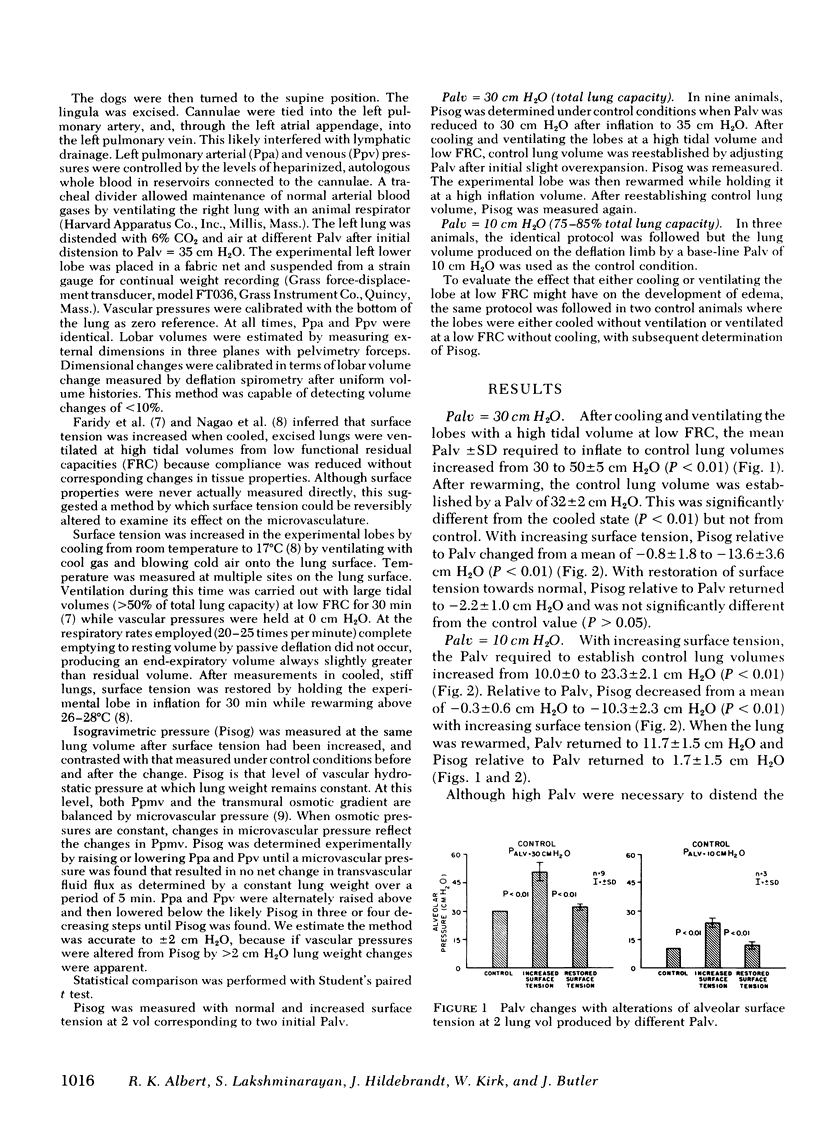Abstract
The possibility that surface tension may affect the hydrostatic transmural pressure of pulmonary vessels and the development of pulmonary edema was studied in anesthetized, open-chested dogs. Isogravimetric pressure (the static intravascular pressure at which transmural osmotic and hydrostatic pressures are balanced such that net fluid flux is zero and lung weight is constant) was measured in nine animals under three conditions: (a) control, normal surface tension, at an alveolar pressure of 30 cm H2O with the apenic lung at room temperature; (b) after increasing surface tension by cooling and ventilating at a low functional residual capacity, at an alveolar pressure sufficient to produce the same lung volume present during control measurements; and (c) after restoring surface tension by rewarming while holding the lung at a high inflation volume, again at the control lung volume. Lung volumes were established from external dimensions and confirmed +/- 10% by deflation spirometry. The isogravimetric pressure (relative to alveolar pressure) was significantly less with increased surface tension than during either the initial control condition (P less than 0.01), or when the surface tension has been restored (P less than 0.01). Similar changes occurred in each of three additional studies performed with control alveolar pressures of 10 cm H2O. Thus, increased surface tension favors fluid leakage presumably because it increases the microvascular transmural pressure.
Full text
PDF



Selected References
These references are in PubMed. This may not be the complete list of references from this article.
- Albert R. K., Lakshminarayan S., Huang T. W., Butler J. Fluid leaks from extra-alveolar vessels in living dog lungs. J Appl Physiol Respir Environ Exerc Physiol. 1978 May;44(5):759–762. doi: 10.1152/jappl.1978.44.5.759. [DOI] [PubMed] [Google Scholar]
- Ashbaugh D. G., Bigelow D. B., Petty T. L., Levine B. E. Acute respiratory distress in adults. Lancet. 1967 Aug 12;2(7511):319–323. doi: 10.1016/s0140-6736(67)90168-7. [DOI] [PubMed] [Google Scholar]
- BRUDERMAN I., SOMERS K., HAMILTON W. K., TOOLEY W. H., BUTLER J. EFFECT OF SURFACE TENSION ON CIRCULATION IN THE EXCISED LUNGS OF DOGS. J Appl Physiol. 1964 Jul;19:707–712. doi: 10.1152/jappl.1964.19.4.707. [DOI] [PubMed] [Google Scholar]
- CLEMENTS J. A. Pulmonary edema and permeability of alveolar membranes. Arch Environ Health. 1961 Mar;2:280–283. [PubMed] [Google Scholar]
- Caldini P., Leith J. D., Brennan M. J. Effect of continuous postive-pressure ventilation (CPPV) on edema formation in dog lung. J Appl Physiol. 1975 Oct;39(4):672–679. doi: 10.1152/jappl.1975.39.4.672. [DOI] [PubMed] [Google Scholar]
- Demling R. H., Staub N. C., Edmunds L. H., Jr Effect of end-expiratory airway pressure on accumulation of extravascular lung water. J Appl Physiol. 1975 May;38(5):907–912. doi: 10.1152/jappl.1975.38.5.907. [DOI] [PubMed] [Google Scholar]
- Faridy E. E., Permutt S., Riley R. L. Effect of ventilation on surface forces in excised dogs' lungs. J Appl Physiol. 1966 Sep;21(5):1453–1462. doi: 10.1152/jappl.1966.21.5.1453. [DOI] [PubMed] [Google Scholar]
- Farrell P. M., Avery M. E. Hyaline membrane disease. Am Rev Respir Dis. 1975 May;111(5):657–688. doi: 10.1164/arrd.1975.111.5.657. [DOI] [PubMed] [Google Scholar]
- Guyton A. C., Granger H. J., Taylor A. E. Interstitial fluid pressure. Physiol Rev. 1971 Jul;51(3):527–563. doi: 10.1152/physrev.1971.51.3.527. [DOI] [PubMed] [Google Scholar]
- Henry J. N., McArdle A. H., Bounous G., Hampson L. G., Scott H. J., Gurd F. N. The effect of experimental hemorrhagic shock on pulmonary alveolar surfactant. J Trauma. 1967 Sep;7(5):691–726. doi: 10.1097/00005373-196709000-00010. [DOI] [PubMed] [Google Scholar]
- LLOYD T. C., Jr, WRIGHT G. W. Pulmonary vascular resistance and vascular transmural gradient. J Appl Physiol. 1960 Mar;15:241–245. doi: 10.1152/jappl.1960.15.2.241. [DOI] [PubMed] [Google Scholar]
- Lamy M., Fallat R. J., Koeniger E., Dietrich H. P., Ratliff J. L., Eberhart R. C., Tucker H. J., Hill J. D. Pathologic features and mechanisms of hypoxemia in adult respiratory distress syndrome. Am Rev Respir Dis. 1976 Aug;114(2):267–284. doi: 10.1164/arrd.1976.114.2.267. [DOI] [PubMed] [Google Scholar]
- McClenahan J. B., Urtnowski A. Effect of ventilation on surfactant, and its turnover rate. J Appl Physiol. 1967 Aug;23(2):215–220. doi: 10.1152/jappl.1967.23.2.215. [DOI] [PubMed] [Google Scholar]
- Nagao K., Ardila R., Sugiyama M., Hildebrandt J. Temperature and hydration: factor affecting increased recoil of excised rabbit lung. Respir Physiol. 1977 Feb;29(1):11–24. doi: 10.1016/0034-5687(77)90113-x. [DOI] [PubMed] [Google Scholar]
- PATTLE R. E. Properties, function and origin of the alveolar lining layer. Nature. 1955 Jun 25;175(4469):1125–1126. doi: 10.1038/1751125b0. [DOI] [PubMed] [Google Scholar]
- Pain M. C., West J. B. Effect of the volume history of the isolated lung on distribution of blood flow. J Appl Physiol. 1966 Sep;21(5):1545–1550. doi: 10.1152/jappl.1966.21.5.1545. [DOI] [PubMed] [Google Scholar]
- Petty T. L., Reiss O. K., Paul G. W., Silvers G. W., Elkins N. D. Characteristics of pulmonary surfactant in adult respiratory distress syndrome associated with trauma and shock. Am Rev Respir Dis. 1977 Mar;115(3):531–536. doi: 10.1164/arrd.1977.115.3.531. [DOI] [PubMed] [Google Scholar]
- Raimondi A. C., Massarella G. R., Pride N. B. The effects of ventilation on the elastic recoil of excised dogs' lungs. Respir Physiol. 1971 Jun;12(2):205–217. doi: 10.1016/0034-5687(71)90053-3. [DOI] [PubMed] [Google Scholar]
- Sladen A., Laver M. B., Pontoppidan H. Pulmonary complications and water retention in prolonged mechanical ventilation. N Engl J Med. 1968 Aug 29;279(9):448–453. doi: 10.1056/NEJM196808292790902. [DOI] [PubMed] [Google Scholar]
- Webb H. H., Tierney D. F. Experimental pulmonary edema due to intermittent positive pressure ventilation with high inflation pressures. Protection by positive end-expiratory pressure. Am Rev Respir Dis. 1974 Nov;110(5):556–565. doi: 10.1164/arrd.1974.110.5.556. [DOI] [PubMed] [Google Scholar]
- Wyszogrodski I., Kyei-Aboagye K., Taeusch H. W., Jr, Avery M. E. Surfactant inactivation by hyperventilation: conservation by end-expiratory pressure. J Appl Physiol. 1975 Mar;38(3):461–466. doi: 10.1152/jappl.1975.38.3.461. [DOI] [PubMed] [Google Scholar]


